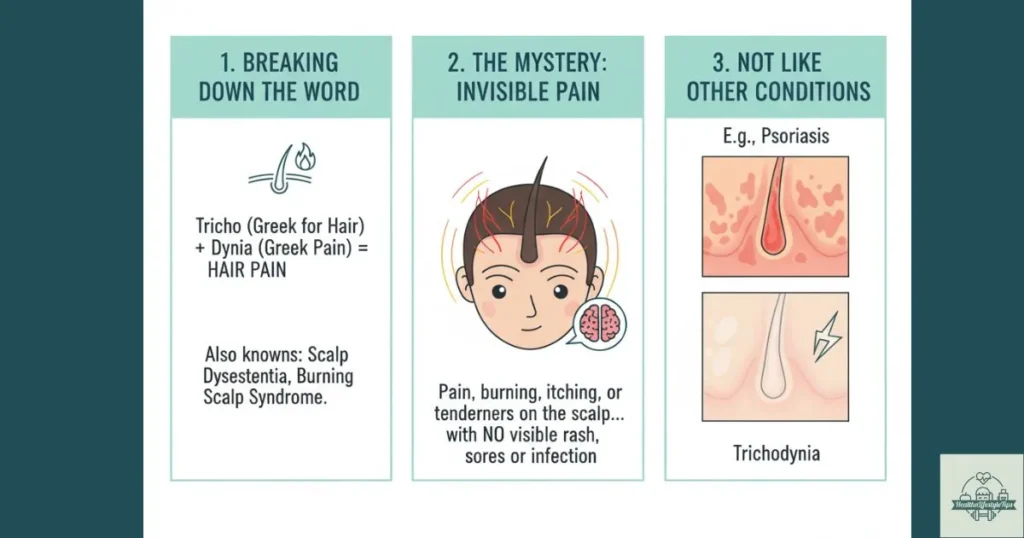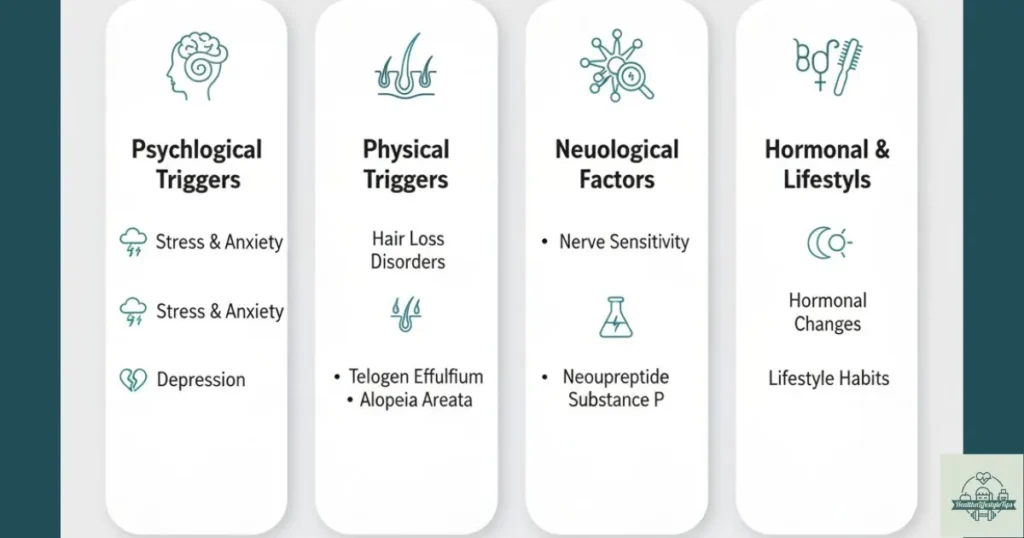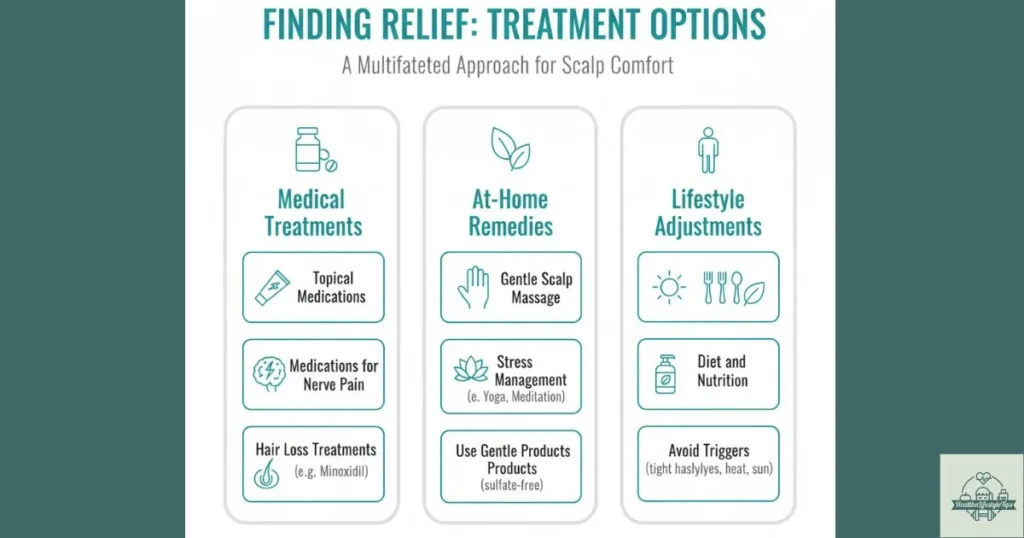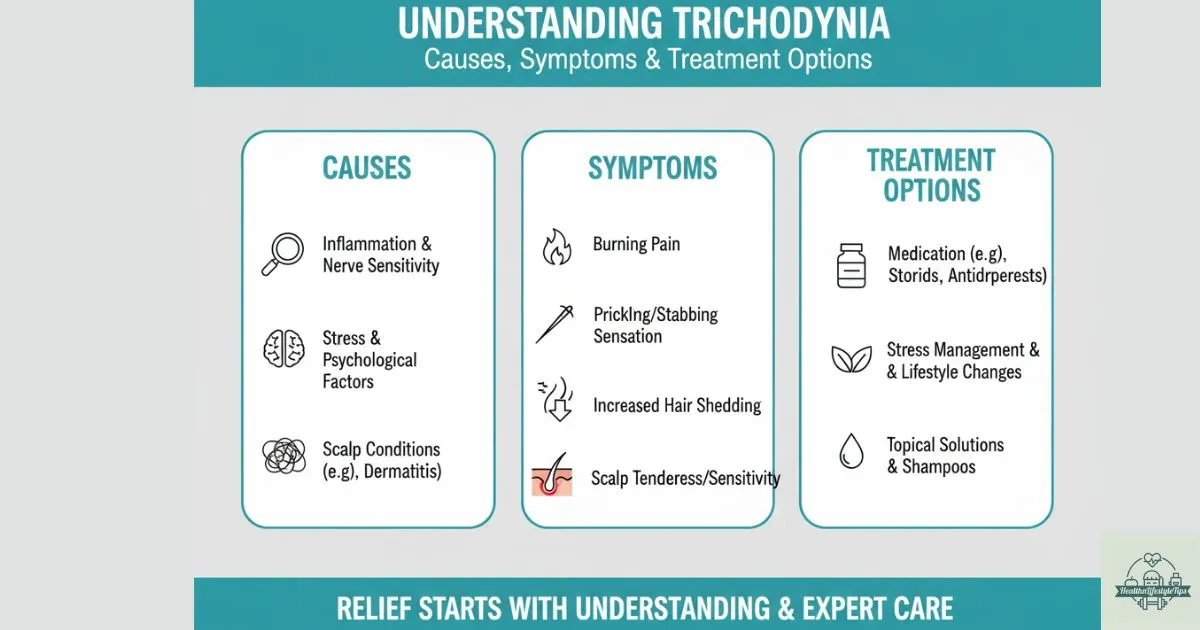Have you ever felt a strange, painful, or burning feeling on your scalp for no apparent reason? It’s a frustrating experience that can leave you feeling worried and confused. If this sounds familiar, you may be experiencing a condition known as trichodynia. It’s more than just a simple itch; it’s a real and often distressing scalp pain that deserves attention.
Understanding this condition is the first step toward finding relief. It’s about knowing you’re not alone and that there are real reasons for the discomfort you feel. This guide will walk you through everything you need to know about what causes this nagging scalp pain, its symptoms, and, most importantly, what you can do about it.
What Is Trichodynia?

Let’s break it down. The word “tricho” comes from the Greek word for hair, and “dynia” means pain. So, trichodynia literally means “hair pain.” It’s often referred to as scalp dysesthesia or burning scalp syndrome. In simple terms, it’s a condition characterized by pain, burning, itching, or tenderness on the scalp, even when there are no visible signs of a rash, sores, or infection.
This condition is different from other scalp issues. For example, scalp psoriasis or dermatitis typically presents with visible symptoms, such as red patches, flakes, or inflammation. With trichodynia, the scalp often looks perfectly normal, which is why it can be so baffling. The pain is real, but the cause isn’t always something you can see on the surface. It’s a sensory issue, meaning the nerves in your scalp are sending pain signals to your brain without an obvious physical trigger.
The Symptoms of Trichodynia
The signs of trichodynia can vary from person to person, but they generally revolve around uncomfortable sensations on the scalp. It’s more than a typical headache; the feeling is located on the skin and around the hair follicles.
Common Symptoms
The most common symptoms people report are:
- A persistent burning feeling: This can range from a mild warmth to an intense, fiery sensation across your scalp.
- Itching: Not just a regular itch, but a deep, hard-to-satisfy one that can feel like it’s coming from under the skin.
- Tenderness to the touch: Even simple acts, such as brushing your hair, wearing a hat, or resting your head on a pillow, can cause discomfort.
Uncommon Symptoms
Some people experience less common, but equally upsetting, symptoms. These can include:
- Tingling or a “pins and needles” feeling: Similar to when a limb falls asleep.
- A crawling sensation: Some describe it as feeling like something is moving on their scalp.
These feelings can be constant or intermittent. For some, the symptoms are a minor annoyance, but for others, they can be severe enough to disrupt daily life, affect sleep, and cause a great deal of emotional distress.
What Causes Trichodynia?

The exact cause of trichodynia is not fully understood, but experts believe it’s linked to several factors working together. It’s rarely just one thing.
Psychological Triggers
Your mind and body are deeply connected. Strong emotions can have a powerful effect on your physical health, and your scalp is no exception.
- Stress and Anxiety: When you’re stressed, your body releases hormones like cortisol. High levels of these hormones can increase inflammation and make your nerves more sensitive, leading to scalp pain.
- Depression: People with depression often have a lower threshold for pain, meaning they feel it more intensely. This can make scalp sensations that might otherwise go unnoticed feel painful.
Physical Triggers
Often, trichodynia appears alongside other hair-related conditions.
- Hair Loss Disorders: These are frequently associated with telogen effluvium (a type of temporary hair shedding triggered by stress or illness) and alopecia areata (an autoimmune condition that causes patchy hair loss). The inflammation around the hair follicles in these conditions might contribute to the pain.
Neurological Factors
Your nervous system plays a huge role.
- Nerve Sensitivity: The condition could be due to hypersensitive nerves in the scalp. These nerves overreact to normal stimuli, sending pain signals when they shouldn’t be sending them.
- Neuropeptide Substance P: This is a chemical in your body involved in sending pain messages to the brain. Some studies suggest that people with trichodynia might have higher levels of substance P around their scalp, making the area more prone to pain.
Hormonal and Lifestyle Factors
- Hormonal Changes: Fluctuations in hormones, such as those that occur during a menstrual cycle or menopause, can affect nerve sensitivity and inflammation.
- Lifestyle Habits: Practices such as wearing tight hairstyles (like ponytails or braids) can cause constant tension on your hair follicles and irritate the scalp. Using harsh hair products with strong chemicals can also contribute to scalp sensitivity.
How Is Trichodynia Diagnosed?
Obtaining a proper diagnosis is crucial because it helps rule out other potential issues. A doctor will typically start by talking with you.
- Medical History and Examination: Your doctor will ask about your symptoms, your general health, your stress levels, and any hair loss you’ve noticed. They will also carefully examine your scalp to look for any visible signs of skin conditions.
- Diagnostic Tests: Since trichodynia often has no visible symptoms, the diagnosis is usually one of exclusion. This means the doctor will first check for other conditions, such as infections, allergic reactions, or scalp psoriasis. They might do blood tests to check for vitamin deficiencies or hormonal imbalances.
- Scalp Biopsies: In some cases, a doctor might take a tiny skin sample from your scalp (a biopsy) to examine it under a microscope. This helps to definitively rule out other inflammatory or scarring conditions of the scalp.
Also Check: Average Forehead Size
Finding Relief: Treatment Options

The good news is that there are many ways to manage trichodynia. Treatment often involves a combination of approaches to tackle the different potential causes.
Medical Treatments
- Topical Medications: Your doctor might prescribe anti-inflammatory creams or lotions, such as topical corticosteroids, to calm the skin.
- Medications for Nerve Pain: For more severe pain, medications that target nerve sensitivity, such as certain antidepressants or anticonvulsants, can be highly effective, even in low doses.
- Hair Loss Treatments: If your scalp pain is associated with a hair loss condition, such as telogen effluvium, treating the hair loss with products like Minoxidil may also help alleviate the discomfort.
At-Home Remedies
You have the power to soothe your scalp at home.
- Gentle Scalp Massage: Using your fingertips to gently massage your scalp can increase blood flow and release tension. Adding cooling oils, such as peppermint or tea tree (diluted in a carrier oil), can provide a soothing sensation.
- Stress Management: Since stress is a major trigger, finding ways to relax is crucial. Yoga, meditation, deep breathing exercises, or simply taking a walk in nature can make a significant difference.
- Use Gentle Products: Switch to sulfate-free, fragrance-free shampoos and conditioners to avoid irritating your scalp.
Lifestyle Adjustments
Small changes can have a big impact.
- Diet and Nutrition: A balanced diet rich in vitamins and minerals supports overall scalp health. Ensure you’re getting enough iron, vitamin D, and B vitamins.
- Avoid Triggers: Pay attention to what triggers your symptoms. Loosen up your hairstyles, reduce the use of heat styling tools, and protect your scalp from the sun.
Read More: Remove Purple Toner from Hair at Home
Frequently Asked Questions
Let’s answer some of the big questions you might have.
Does Trichodynia Cause Hair Loss?
This is a very common worry. The short answer is that trichodynia itself does not directly cause hair loss. However, it is very often a companion to hair loss conditions. The inflammation and stress associated with the pain can sometimes worsen hair shedding. So, while the pain isn’t pulling your hair out, the underlying issues causing the pain might be.
How Long Does Trichodynia Last?
The duration is different for everyone. For some, it might be a temporary issue that resolves in a few weeks or months once the trigger (like a stressful event) is gone. For others, it can become a chronic, long-term condition that requires ongoing management. The key is to find a treatment plan that works for you.
Can Stress Alone Trigger Trichodynia?
Absolutely. The brain-scalp connection is incredibly strong. For some people, a period of intense psychological stress is the only identifiable trigger for their scalp pain. Managing your mental well-being is not just good for your mind—it’s essential for your scalp, too.
Read Also: Turkish Hairlines: From Meme to Medical Marvel Guide
Unique Insights: What Others Don’t Tell You
Beyond the basics, there are a few more things to know about managing this frustrating condition.
- The Connection to Mental Health: Don’t underestimate the emotional toll of chronic pain. Feeling constant discomfort can lead to anxiety and feeling low, which in turn can make the pain worse. It’s a vicious cycle. Speaking with a therapist or counselor can be just as important as seeing a dermatologist.
- How Sleep Quality Matters: A good night’s sleep allows your body to repair itself and regulate hormones. Poor sleep can increase inflammation and stress, making your scalp more susceptible to sensitivity. Prioritizing 7-8 hours of quality sleep can be a game-changer.
- The Role of Hydration: Staying hydrated is vital for healthy skin, and your scalp is no exception. Drinking enough water helps maintain your skin’s moisture balance and can reduce dryness and irritation.
Take Control of Your Scalp Health
Living with trichodynia can be challenging, but you don’t have to suffer in silence. By understanding the causes, recognizing the symptoms, and exploring different treatments, you can find a path to relief. Start by being kind to your scalp and your mind. Try gentle products, practice stress reduction, and pay attention to your body’s signals.
If your scalp pain persists or is affecting your quality of life, don’t hesitate to seek professional help. A doctor or dermatologist can provide a proper diagnosis and create a personalized treatment plan to get you feeling comfortable again. You deserve to feel good from head to toe.
